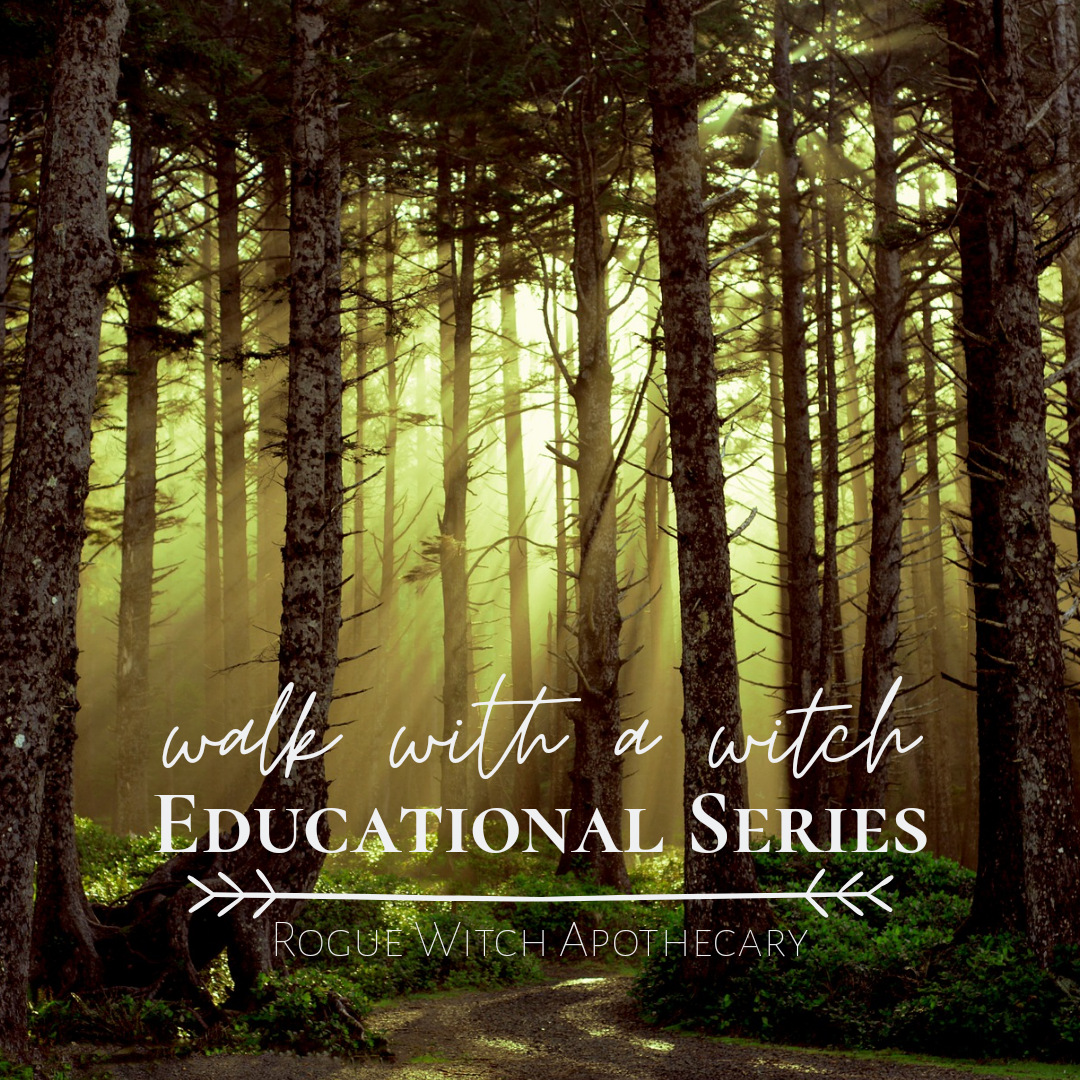As the buds awaken and the fowl begin to flirt, our senses are in full bloom, attune with the peak of spring. May 1st and its eve represent the height of the spring season in the northern hemisphere and have been celebrated by many people throughout history as a time of fertility, a time to rejoice in the passing of the dark days, and a time to cleanse.
This Walk With A Witch essay will be the first in the series covering a pagan holiday and its traditions. The pagan holiday in focus for this entry is Beltane, an ancient Irish-Celtic fire festival that is still celebrated and acknowledged today to mark the return of summer. Pagans typically celebrate four main sabbats, or holidays, known as earth sabbats or cross quarter days, and four lesser holidays, or solar sabbats, throughout the year. My interpretation of why these holidays are termed ‘greater’ and ‘lesser’ is that during this time of history humans were earth-centric and so seemingly deemed the holidays related to the earth's seasons as the greater of the two distinctions. The four main sabbats, celebrated by the majority of witches and pagans are Samhain (October 31- November 1), Imbolc (February 1-2), Beltane (April 30-May 1), and Lughnasadh (August 1-2). The four lesser holidays are Ostara/Spring Equinox (March 19-21), Litha/Summer Solstice (June 20-22), Mabon/Autumn Equinox (September 21-24), and Yule/Winter Solstice (December 20-23). The holidays are marked by the sun’s journey over the course of the year as well as the changing of the seasons, which means that the dates of the holidays will vary slightly from year to year.
Beltane is one of the four Celtic cross quarter day festivals and is the main fire festival of the year. The Celts celebrated the transition from darkness into the light by acknowledging the importance of the dark days and celebrated the growing fertility of the land and return of the sun by lighting bonfires. Traditionally the Celts lit what is referred to as a ‘neid fire’ to protect their livestock from diseases during the changing of the seasons. The word Beltane roughly translates to ‘Bright Fire’ indicating the importance fire played on this holiday. On this day the townsfolk would all extinguish their hearth fires that had sustained them throughout the winter, and a new neid fire would be lit, which was then used to relight all the hearth fires in the town, thus connecting all the townsfolk together with a sacred fire. The neid fire was also used to light two large bonfires situated opposite each other alongside a road or a pathway. Shepherds would then herd their livestock between the two fires in the belief that the fire would cleanse their stock of any diseases before being put out to pasture. I liken this process to the burning of herbs to cleanse and purify that’s found throughout many cultures of the world. Smoke has been used to kill bacteria and viruses for centuries even if they didn’t realize the science behind it. Beltane was a time to celebrate the blossoming earth and so foliage was collected and used to decorate homes and adorn maidens, giving tribute to the fertile season. The festival was also a time of courtship, a time to celebrate our own sensuality and sexual energy, and many pagans choose this holiday to perform handfasting/marriage ceremonies.
The secular holiday May Day is believed to be derived from Beltane, although some sources say its origins are rooted in the Roman holiday Floralia, a celebration of the earth and fertility, and was dedicated to the goddess Flora. Walpurgis is the German May Day celebration of the return of summer and also employs fire in its festivities. Most would recognize the iconic May Pole traditionally danced around during May Day festivities. It’s uncertain exactly where this tradition originated from, but it is still practiced today as a celebration of the joy of new life.
In my own personal practice, Beltane is an important time to forage, start crops, and prepare for the summer's bounty. Living in the lush Pacific Northwest, there are many plants that are perfect for foraging during this time of year. Out here on the coast, the winters are so mild that the elder trees flower in early-mid spring (it typically blooms in late spring/early summer in other regions) making it a perfect plant to harvest for Beltane. The elderflower can be used for a wide variety of treats including syrups, cakes, scones, and even for skin care products. Nettle is another plant emerging in the meadows, their young leaves bursting with vitamins and minerals. Soft shoots of comfrey are also just begging to be made into healing salves. My partner Eric and I spend many a dewy morning gathering medicinal and edible plants to be used throughout the year, connecting with our landscape and honoring the wisdom of the earth.
I invite you to pay tribute to this time of year, to acknowledge the return of the long summer days and the bountiful harvests to come. Connect with your ancestors and the earth by lighting a candle, burning some sage, or having a bonfire. Don’t lose hope during the dark days, and remember there will always be light following close behind.
Below you will find my own recipe for a floral simple syrup, crafted from plants that are blossoming in my region during this time, as well as a recipe for Bannocks, a traditional scottish oat cake eaten during Beltane.
Stay inquisitive, be persistent, live holistically, laugh, cry, and always hail yourself.
Beltane Floral Syrup - Elderflower Lilac
1 cup Lilac flowers
1 cup Elderflowers
4 cups water
4 cups Organic cane sugar
Instructions
Add flowers and cool water to a large jar. Let steep for 24-48 hours to create a slow-infused, herbal tea. Pour herbal tea, including flowers, into a pot on the stove. Add sugar and simmer for 20 minutes (do not boil!) Strain flowers from syrup using a fine mesh sieve and store in the refrigerator for up to a month. Use as a sweetener for coffee, tea or alcoholic beverages. Our favorite way to use the floral syrup is to pour over warm Bannocks.
Beltane Bannocks with Flora Syrup
· Oatmeal (4oz)
· Baking soda (a pinch)
· Salt (a pinch – we’re trying to keep this heart-friendly)
· Butter (1 tsp – use unsalted)
· Hot water (about half a cup)
Instructions
Mix together the oatmeal, salt and baking soda in a bowl. Leave a small depression in the middle of the oatmeal mix, melt the butter and add this to the space you have made. Mix all of this together and then add in enough of your hot water to make a stiff dough, and then roll this into a ball.
Scatter some oatmeal on a breadboard or clean surface and take your ball of dough and press it out I divide my dough in two and form a thick, 4 inch diameter pancake. You can also roll the dough into a single large pancake and grill, whichever method you prefer. If the dough is getting sticky, rub both sides with more dry oatmeal.
Heat up a skillet on medium heat, add oil of your choice, I like to use coconut oil for its health benefits and flavor. Grill each side of the bannock until it’s golden brown and toasty.
Bannocks are usually eaten warm (just let them cool a bit after cooking) on a bright Beltane morning or eve and served with butter and a special sheep cheese (from the sheep who has just lambed) and a thin custard like drink, known as a Caudle, a bit like eggnog. We like to eat them warm with a bit of butter and floral syrup. Recipe and instructions adapted from Cailleachs Herbarium (link below).
https://cailleachs-herbarium.com/2015/04/the-beltuinn-bannock-bonnach-bealltainn/
https://beltane.org/about-beltane/
https://www.learnreligions.com/quarter-days-and-cross-quarter-days-2562061
https://www.controverscial.com/The%20Sabbats.htm
https://wiccaliving.com/wheel-of-the-year-wiccan-sabbats/
https://www.goddessandgreenman.co.uk/beltane
https://www.britannica.com/topic/Beltane
Jason Mankey, Witch’s Wheel of the Year, 2019
Photography by Eric Toennis and Laura Ursula Quinn
Want to learn more??? Journey into the world of the Rogue Witch:
A modern day alchemist and herbal artist, Pacific Northwest born and raised witch Laura Ursula Quinn spends her days dreaming up concoctions of herbal remedies and natural skin care products. The Rogue Witch is passionate about sharing her love of herbal medicine and helping others with her uniquely crafted herbal and witchery goods imparted with her very own magic. Enthralled with the magic of the woods, Ursula can often be found out collecting plants, dipping her toes in creeks, and scavenging for treasures.





